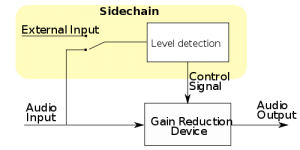“Sound Smack” by AfroDJMac: Sidechaining Makes Your Tracks Interact
Hello, this is New York-based producer, songwriter, guitarist, and live electronic musician AfroDJMac. I like to describe my music as being futuristic yet nostalgic: it’s a blend of indie rock, electronica, glitch, and chip tunes, all wrapped up into catchy, fun, and sometimes introspective songs. It’s music that is great for a party, yet has another layer — perfect for a night alone contemplating life’s larger questions.
I’ve gotten myself pretty involved in the Ableton Live community by releasing a free Ableton Live Device Rack every week for the last 20 weeks and have no plans of stopping. I try to create instruments and effects that have lots of character and are practical for the live electronic musician. Stop by my site and check them out (even if you aren’t an Ableton Live user, the samples may come in handy).
I’m excited to write for SonicScoop to share some of the knowledge that I‘ve picked up along the way. For my big debut, let’s take a look at the dark art of sidechaining.
Sidechaining — What It Is
Sidechaining is the technique of using one sound signal to change certain parameters of a different sound signal.
Here’s a simple, real world example: Imagine we’re both listening to our iPods. If your music gets to a certain loudness threshold, you turn down your iPod; when the music drops below that loudness level, you raise the volume of your iPod back up. If we were “Sidechained” together, when your music reaches that loudness threshold, you would turn down my iPod, and when your music drops below that loudness level again, you turn my volume back up. So in this case, my volume is changed depending on the volume of your iPod.
The most basic example is known as “ducking” and it stems from radio broadcasting. Engineers placed compressors onto background music, but sidechained them to the announcer’s voice. So when the announcer spoke, the background music would get lower, and when he stopped speaking, the music would get louder again. This allowed listeners to hear the music clearly, but when the announcer had something to say, it wouldn’t be drowned out by background music.
It wasn’t long before audio engineers began using sidechaining in music for interesting effects. Following are some of the stimulating possibilities when you sidechain a compressor, gate, and filter.
Note: I used Ableton Live to demonstrate the following techniques, but the principles are the same in any DAW. Ableton Live users can download the Live Set here. And this handy dandy video explains it all with luv:
Sidechain Compression
By sidechaining a compressor to a different sound source, many different effects can be achieved, and there are various ways to set up a sidechain. Let’s start by looking at the analog word, where most hardware compressors/gates have an input marked “sidechain.” Though the method may vary between different pieces of gear, usually sidechaining is a matter of simply patching your desired sound source into the sidechain input. The compressor then reacts to that signal instead of the one that is actually being compressed.
Ableton Live makes sidechaining a breeze. On the top left of your Compressor, Gate, and Auto Filter plug ins, there is a small yellow arrow. Clicking on this arrow opens up some new parameters, one of which is a rectangular button labeled “Sidechain.” Click this button, and then below you can choose the source you want the device to react to.
For example, if I had a compressor on the bass and wanted to sidechain it to the bass drum, I would click the yellow arrow, click the Sidechain button, and then select my bass drum from the drop-down menu.
Live also allows you to place an EQ filter on the sidechain signal. This is extremely useful if all of your drums are on one track. In order to isolate the bass drum sound, simply click the EQ button, select the low pass filter and lower the frequency until the compressor is only reacting to the bass drum hits.
The process is slightly different from DAW to DAW, but the idea is more or less the same — turn on the sidechain and select the source you want the device to listen to. Here are some ways to apply sidechain compression in your productions:
–Sidechain Compressing the Bass: Both the bass and the bass drum sit in extremely low frequencies, and these signals compete for the ear’s attention. Raise one and the other sounds weak, raise the other and things start getting muddy.
Electronic music producers who want to keep the dance floor moving need big bass sounds and pumping bass drums, so they began sidechaining a compressor on the bass to the bass drum. When the bass drum hits, the bass quickly “ducks” down in volume and then comes back up to normal volume depending on the compressor’s release time. This technique can be used for a subtle effect, or at more extreme settings can create an exciting rhythm “sucking” feeling as the bass is “breathing” in time with the beat. To achieve this effect, use extremely high ratios and experiment with the release time.
-Giving Movement to Instruments: Other instruments can be sidechained to the bass drum, or any other instrument. Often, long sustaining pad sounds will be sidechain-compressed to the bass and/or snare drum. Those normally static pads will be given movement at the rhythm of the specified drum sounds. This can really help get a track moving. Get creative, consider sidechaining things like the rhythm guitar to the lead guitar, so when that rad solo kicks in, the rhythm guitar backs up a bit. Some thoughtful sidechaining compression at subtle, and even extreme settings can create the sensation of the music working together and reacting to itself.
-Background Music Ducking: By placing a compressor on a background music track and sidechaining that signal to your speaking voice you can make both the music and voice easy to hear. Set the threshold of compressor so that it is activated when you speak and releases when you finish.
-Bring Clarity to Mixes: Ever slap a delay or reverb on a vocal and find it just washed everything out? Create a send and place a healthy amount of reverb/delay on it. Then after those effects, place a compressor and sidechain the compressor to the vocal track. Now you get the best of both worlds. The reverb/delay is “ducked” out of the way when the vocals sing, but as soon as they are done, they swell back up in volume, without interfering with the clarity of the vocals. Sidechain compressing effects can be an exciting way to add movement and clarity to a song.
Sidechaining a Gate
You can place a gate on a sound and have a different sound trigger the opening and closing of that gate.
For example, if you have a noise sweep, you can place a gate on it and sidechain it to the hi hats. Adjust the threshold to taste and you will take that long noise sweep and create something choppy that moves in sync with your hi hats. Try muting the hi hats, so that only the chopped up noise sweep can be heard. Also, experiment with inverting the gate so that the noise sweep sounds only when the hi hat is not playing.
These techniques can help add dynamics and tension to a track. Experiment with sidechained gates on effect sends to turn effects on and off with another signal.
Sidechaining a Filter
Just as you can sidechain a gate or compressor, you can sidechain a filter to move with another signal. This can be handy for giving life to percussion tracks by sidechaining its filter to the drums, or moving just the low frequencies of a bass when the bass drum hits. Placing a bandpass filter on a synth track and sidechaining it to drums or percussion can create a nice rhythmic wah wah type effect on that synth.
—-
Chaining Reigns
Sidechaining is a technique that can breathe life into your productions: Its effects can range from the subtlest touch to total song changers.
Basically what you are doing when you sidechain is getting your music to interact with itself. Think about which instruments are competing for your attention, which ones complement each other and experiment with sidechaining them together. Musicians naturally interact with each other, and sidechaining can be an effective way to emphasize and recreate those interactions.
AfroDJMac: (noun) One Man Musical Aphrodisiac; Simultaneously Futuristic and Nostalgic Indie Dance Party, blending Rock, Dance, Glitch, and Old Video Games.
Please note: When you buy products through links on this page, we may earn an affiliate commission.









Mobilohm
September 12, 2011 at 3:41 am (14 years ago)Nice to see the various applications of sidechaining …. thanks
Mobilohm
September 12, 2011 at 3:44 am (14 years ago)Thanks for showing various applications of sidechaining.
James Van
September 24, 2012 at 4:09 am (13 years ago)All this time I’ve never used sidechaining cos I just didn’t see how it was important. But this vid is so clear and concise, you just shed the light on sidechaining for me! I’m gonna use it now!! Thank you, AfroDjMac!!!
Sverre Eier
September 29, 2012 at 7:29 pm (13 years ago)I love you, man.